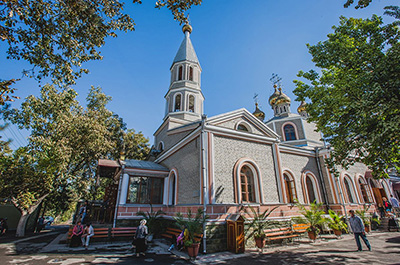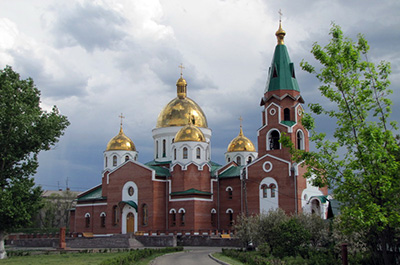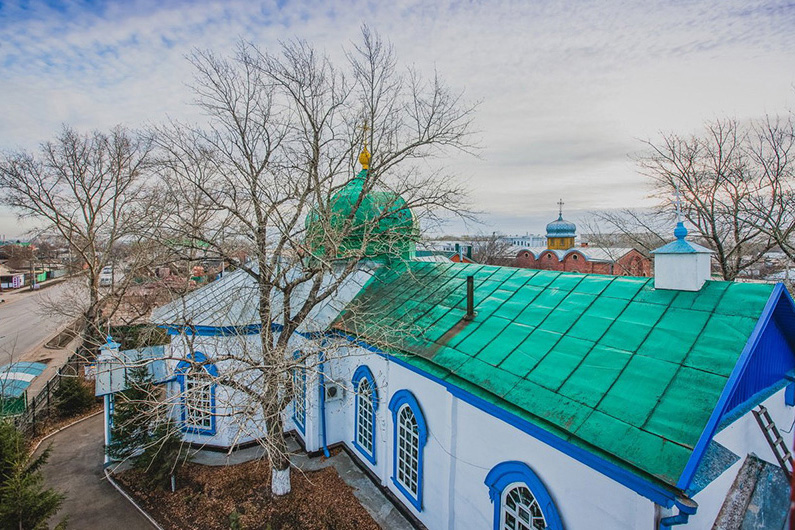
The Iveron-Petropavlovsky Convent has been opened in the Kostanay Diocese
- 26.07.2024, 17:15
- Новости на английском языке

On July 25, 2024, a meeting of the Holy Synod of the Russian Orthodox Church was held at the Patriarchal and Synodal Residence in the Danilov Monastery in Moscow, chaired by His Holiness Kirill, Patriarch of Moscow and All Rus'.
The Holy Synod, in connection with the request of Metropolitan Alexander of Astana and Kazakhstan, decided to open the Iveron-Petropavlovsky Convent in the village of Oktyabrskoye, Kostanay Region, in the Kostanay Diocese and appoint nun Nika (Otroshchenko) to the post of abbess of the newly established monastery.
The candidacy of nun Nika (Otroshchenko) for the post of abbess was presented by the Synod of the Orthodox Church of Kazakhstan.
The opening of the Iversko-Petropavlovsky Convent essentially became the revival of the ancient Iversky Monastery.
Abbess Nika (in the world - Nina Otroshchenko)Abbess Nika (in the world - Nina Otroshchenko) was born on October 6, 1953 in the city of Kustanai, Kazakh SSR. She was baptized in 1953 in the Constantine and Helen Church in the city of Kustanai.
From 1960 to 1969, she studied at the secondary school of the Tobol station, Taranovsky district, Kustanai region. From 1969 to 1970, she studied at the secondary school of the Kustanai district.
In 1976, she graduated from the Rudny branch of the Kazakh Polytechnic Institute, faculty of industrial and civil engineering, specializing in "civil engineer". In 1981 she graduated from the Kustanai University. In 1975 she worked as a cleaner in the Kustanai housing management office No. 2 in the city of Kustanai. In 1976 she worked as a foreman in the Kachirskaya RayMKSO of the Pavlodar region, Kachiry urban-type settlement. From 1976 to 1977 she worked as a foreman in the Uspenskaya RayMKSO of the Pavlodar region, Uspensky district. From 1977 to 1991 she worked as a foreman, senior engineer, and linear mechanic at the Kustanaiselstroy-13 trust in the city of Kustanai; From 1991 to 1992 she worked as the head of the PGO SMU PO Khimvolokno, in the city of Kustanai. From 1992 to 2005 she was engaged in individual entrepreneurship. From 2005 to 2015, she worked as a civil engineer, designer, head of the construction project team, chief project engineer, TOO PIP "Kostanayvodproekt", Kostanay. In 2015, she retired.
In 2019, she was tonsured a nun with the name Nika in honor of the martyr Nika of Corinth. From 2020 to 2023 - head of the economy at the Church of the Archangel Michael in Kostanay. In 2020, she graduated from the Theological and Missionary Faculty at the Almaty Orthodox Theological Seminary. In 2023, she graduated from the regent's department of the Almaty Orthodox Theological Seminary.
In June 2023, with the blessing of Metropolitan Alexander of Astana and Kazakhstan, she moved with the female monastic community to the Peter and Paul Church in the village of Oktyabrskoye, where she began to revive the Iversky Monastery. On April 26, 2024, with the blessing of Metropolitan Alexander of Astana and Kazakhstan, she was appointed acting senior sister of the Iversky-Peter and Paul Convent in the village of Oktyabrskoye, Kostanay Region.
Kostanay Iversky Convent
The history of the Iversky Monastery is inextricably linked with the founding of the city of Kustanay (modern Kostanay). Pious girls lived in the families of the first settlers, whose souls were aimed at dedicating themselves to God. The Central State Archives of the Republic of Kazakhstan have preserved petitions from 1883-1885 "On permission for the villagers of the city of Kustanai, girls Anna Zhutova and Fevronia Silantieva, with others, to establish a prayer house." In 1883, the sisters asked to open a prayer house, and in 1884 - a monastery. However, the highest officials, represented by the military governor, Major General Protsenko, refused them in this matter with the note that "... to fulfill their desire, they can enter existing prayer institutions within Russia." Another reason for the refusal to establish a monastery in Kustanai was that this would require the allocation of land for buildings, vegetable gardens, etc., and the plot allocated for Kustanai is very small in comparison with the large number of residents in it.
But the sisters were quite determined to organize their good work.
In the summer of 1887, the settlement of Kustanai was visited for the first time by His Grace Bishop Makarii (Troitsky) of Orenburg. The girls tearfully asked the bishop for a blessing for their monastic feat. But since the sisters lived in the homes of their relatives, the archpastor said that he would bless this community if they lived together. Bishop Makarii's words prompted the sisters to action - 25 women, initially having no material resources, began to work hard. Two girls - Elena Borodina and Ksenia Sadchikova - sowed grain for several years, and gave the proceeds to provide for the community. By that time, the number of sisters was increasing, which also contributed to the successful outcome of the collection of material resources for the community.
At the end of 1889, Hieromonk Seraphim arrived in the city from the Holy Mount Athos. He brought a copy of the miraculous Iveron Icon of the Mother of God to Kustanai. The sisters accompanied the relic to homes where prayers were held before the icon of the Mother of God, and replaced Hieromonk Seraphim as psalm-readers. He, in turn, encouraged the sisters to undertake monastic labors and advised them to purchase a house for the community. Hieromonk Seraphim personally found a five-walled house in the Verkhne-Kustanai settlement, which was purchased on February 20, 1890, for 615 rubles, payable in installments. Six months later, Hieromonk Seraphim returned to the holy Mount Athos and sent the Iveron Icon of the Mother of God as a blessing to the sisters. At the end of July 1890, Bishop Macarius arrived in the city of Kustanai again and visited the sisters' dormitory, where they asked him to open a community. But the bishop again refused their request, citing the fact that, according to the law, opening a community required financial resources and a large plot of land for the construction of cells and outbuildings. The sisters began to tearfully beg the bishop, and he, deeply touched by their sincere impulses and seeing their firm determination, told them that they would have to be patient, and gave the dean and district chief the order to convince the city residents to allocate land to the community. In 1892, there was an epidemic of cholera, and then typhus. The sisters selflessly began to show mercy to the suffering: they went to the sick with provisions, cleared snow from the houses of the sick, cared for them, and also took care of the funerals of those who died from the epidemic. Seeing such zeal and sincerity of the sisters, the city deputies, after the sisters submitted a petition for the allocation of land for the community on September 21, 1892 to the governor of the Turgai region, decided this matter positively. In 1893, 250 dessiatines of land were allocated for the community 15 miles from the city and 6 dessiatines for an estate on the left bank of the Tobol River.
On May 25, 1894, by decree of the Holy Synod number 2281, the Kustanai Iverskaya women's community was officially opened, which included 25 women of the peasant class.
By the spring of 1895, the community already had 80 sisters; the blind, the poor and the sick found shelter with them. In connection with the growth of the community, on May 24, 1895, permission was given by the spiritual consistory to begin the construction of a monastery church and the construction of spacious cells. On August 8, 1895, nun Anna (in the world Elena Stefanovna Borodina), who contributed more than others to the founding of the community, was confirmed as the abbess of the Kustanai Iverskaya women's community; Ksenia Sadchikova was appointed treasurer.
In August 1895, Bishop Makarii visited the city of Kustanai for the third time. The bishop also blessed the construction of a refectory church in the community. On September 9, 1895, priest Alexei Protopopov, a teacher at the Obaninskaya church parish school and a student at the Orenburg Theological Seminary, was assigned to the Kustanai Iverskaya women's community. On September 21, 1895, priest Maxim Khudonosov was transferred to the Iverskaya women's community. On September 30, 1895, a significant event took place - the dean priest Nikolai Malyshev consecrated the church of the Kustanai Iverskaya women's community in the name of the Holy Trinity, and from October of the same year, services began to be held at the church on all Sundays, holidays and three weekdays.
In 1896, according to the report of nun Anna to the dean of monasteries and communities of the Orenburg diocese, Archimandrite Moses, it became known that a townsman of the city of Kustanai, Taras Dmitrievich Putiev, donated a house and 100 poods of wheat on the condition that a bell weighing 4 poods would be cast for the church with the cost of his donation.
On February 13, 1897, the priest of the Michael the Archangel Church of Kustanay was assigned to the Kustanay Iverskaya Women's Community, Vasily Gilyarov, who served in this position until 1916 (he was dismissed due to illness). On October 7, 1897, a report number 9986 was written to Bishop Vladimir (Sokolovsky-Avtonomov) of Orenburg and Uralsk on behalf of the abbess of the Iverskaya Women's Community, nun Anna, with a petition for permission to build a wooden church at the community. In 1899, changes were made to the original project. On September 29, 1901, this temple was consecrated by the dean, Archpriest Pavel Podbelsky, in honor of the Iverskaya Icon of the Mother of God. Another 8 clergymen took part in the consecration. On October 3 and 4, 1901, a monastic tonsure took place in the newly built church.
On September 1, 1898, a church literacy school was opened at the Iverskaya women's community, where 17 people studied. The priest Vasily Gilyarov worked as a religious teacher, and the novice Marina Shalygina worked as a teacher.
On June 18, 1908, at the request of the abbess, nun Anna, the priest of the village of Lavrentyevsky, Kustanay district, Petr Kasenkov was transferred to the second priestly position in the Kustanay Iversky Women's Monastery.
The monastery had two farmsteads: the official one (near the village of Zhdanovka) and the unofficial one (the modern address is the village of Oktyabrsky, Kostanay district), the land under which was leased from the local population. On the site of the official farmstead, near the village of Zhdanovka, a prayer house was built and consecrated on May 29, 1909 in the name of the Great Martyr Paraskeva. Here, cells for the sisters and utility rooms were also built. In 2023, the exact location of the monastery courtyard was determined using a copy of the 1895 map of the Kustanai district. During the inspection of the former monastery courtyard, remains of brick walls, building foundations, numerous pits, probably from cellars, etc. were found. A sickle, remains of dishes, etc. were also found (all the exhibits found were transferred to the diocesan museum of the city of Tobyl). In 1905, a church orphanage was opened on the site of the unofficial courtyard. Since 1903, the abbess, Abbess Anna, regularly submitted petitions to the higher authorities to transfer the lands of the unofficial courtyard to the permanent possession of the monastery due to the fact that the site near the village of Zhdanovka turned out to be unfavorable for agricultural cultivation. Abbess Anna personally came to St. Petersburg to resolve this issue, where she met with Grand Duchess Elizabeth Feodorovna. And in 1913, the state gave the lands in the area of the modern settlement of Oktyabrsky in the Kostanay district into permanent possession of the monastery. Thus, the site near Zhdanovka was confiscated, and all the buildings were moved to a new location. In 1917, a church in honor of St. Nicholas the Wonderworker was built on the territory of the courtyard (in the current settlement of Oktyabrsky). In 1915, by the decision of the Holy Synod, the abbess of the Kustanai Iversky Convent, Abbess Anna, was dismissed from her position in accordance with her request due to illness, and the treasurer of the Chelyabinsk Odigitrievsky Convent, nun Raphaela, elected by the sisters of the convent, was appointed to the vacant position of abbess, with her elevation to the rank of abbess.
During the First World War, on July 22, 1915, an orphanage for girls - soldiers' orphans, in the amount of 15 people, was opened at the convent. On February 25, 1916, the Turgai Governor submitted a petition to the Chancellery of the Council of Ministers for the Romanov Committee to provide assistance to the Iversky Convent of the Turgai Region for the construction of an orphanage and the maintenance of 30 orphans - children of fallen soldiers. On September 3, 1916, priest Veniamin Ioannovich Palmin was appointed cleric of the Kustanai Iversky Convent. He also became the head and religious teacher of the monastery's parish school.
Significant changes in the life of the monastery occurred after the revolution. In 1920, a commission was created from representatives of the UzemOtdel, Komkhoz, and the Management Department to register the monastery property, which was instructed to "immediately begin work on accepting the monastery property for registration." On November 30, 1925, the nationalization of the building of the convent took place, which was given to the Department of Public Education.
On January 15, 1930, the convent was closed. From January 24, 1930, a technical school was located in the monastery buildings. Residential buildings were used for storage facilities, a pig farm and a rabbitry.
Before the revolution, several dozen nuns and about 140 novices worked in the Iversky Monastery. After the monastery was closed, many of them remained to live in the city in private apartments and houses. In 1929, the confessor of the monastery, Archpriest Pyotr Kasenkov, was sentenced "to 3 years in a concentration camp for opposing the closure of the convent." Nun Anna Danilova was also convicted along with him. In 1937, mass repressions began, which also affected nuns. In the case of the "Churchmen of the Cemetery Church" in August-November, 39 people from among the clergy, monks and parishioners were arrested, 32 of them were shot (including 24 nuns) and buried in an unmarked common grave, 7 were sentenced to imprisonment in a labor camp for 10 years. Among those convicted and executed was also the monastery's confessor, Archpriest Pyotr Kasenkov and Abbess Paraskeva Vodyasova, who was the abbess of the monastery at that time. By 1961, only 25 of the 180 nuns remained alive. Many of them lived in Kustanai, others in the village of Stepanovka (Mendykarinsky district of the Kostanai region), and later some ended their earthly journey in the village of Borovskoye, Mendykarinsky district, where they were ministered to by Archpriest Nikolai Moiseyev. In 1932, the monastery church in Kustanai was destroyed, but some buildings survived: you can still see the monastery buildings along Krasnoselskaya Street near the TV Tower. One of them houses a school of technical creativity, another houses a children's psychoneurological boarding school, and the rest are privately owned. In the village of Oktyabrsky (Kazakhstanets), by 1990, a building that previously belonged to a convent survived, where the church in honor of the holy supreme apostles Peter and Paul is currently located. In 1992, this building was transferred to the Uralsk and Guryev diocese. In June 1992, 0.6 hectares of land were allocated for the needs of the temple. On June 2, 2023, by a court decision, the church building and land were transferred to the ownership of the Kostanay and Rudny diocese of the Orthodox Church of Kazakhstan. On July 12, 2023, a minor consecration of the church in honor of the apostles Peter and Paul took place. With the blessing of Metropolitan Alexander of Astana and Kazakhstan, the revival of the monastery began. Pilgrims come to the village of Oktyabrsky to help restore the community. Cells have been built in which monastics, novices and sisters of mercy live.





















